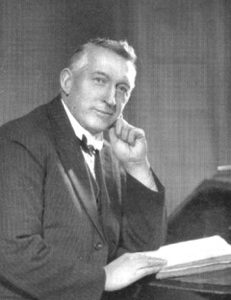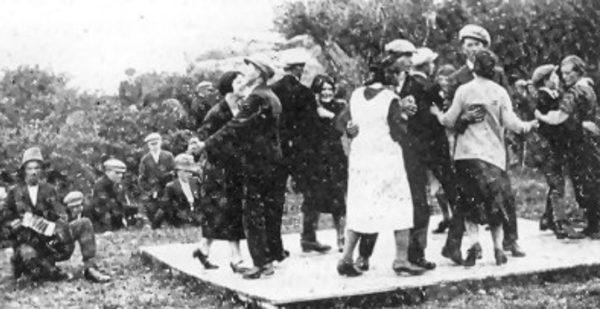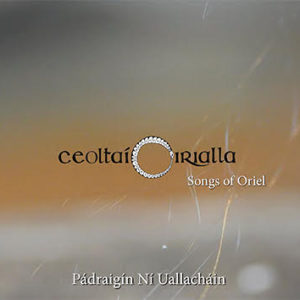Amhrán na Craoibhe
Background
(see A Hidden Ulster pp. 96-106 for detailed references and information)

St Moninne Churches at Killeavy site of the annual pattern to the holy well.
This is a seasonal summer song of calendar customs unique to the Oriel tradition. It has connections with the older seasonal festival of Bealtaine (May) which was held to celebrate the beginning of the summer half of the Celtic year. It was also entitled Lá Fhéile Blinne (St Moninne’s Feastday) and Ag a’ Phatrúin (At the Pattern) showing a connection between this song and the religious celebrations of the pattern of Blinne at Killeavy monastery on July 6.
This connection and overlapping of traditions was likely to have occurred when the Bealtaine and Lúnasa traditions were incorporated into the Christian celebrations of Feastdays and Patrons, possibly during the Middle Ages. It was collected in 1908 by Enrí Ó Muiríosa (AHU pp. 363-65) from Mrs Susan/Sarah Humphries (AHU pp.394-7) from Doctor’ Quarters Lislea. Co Armagh.

Enrí Ó Muireasa
The traditions and calendar customs associated with Bealtaine survived well into the early part of the twentieth century in Monaghan, south Armagh and in Louth as part of the local pattern, at Maytime and midsummer: ‘the Omeath patron was famous in old days and people came from all parts of Killeavy, Cooley and Lordship (and Faughart). The girls of the different townlands vied with each other in making dolls for this social occasion and the competition also led to faction fights.’ The dolls were called Babóg a’ Phátrúin, Craobha or Géaga (Pattern Dolly, Garland or Branch).
One source from Farney in Monaghan recalled that the song Babóg na Bealtaine (the May Doll) used to be sung by the youths and maidens on May Eve while they carried around the ‘May Baby’ from house to house. This song, Amhráin na Craoibhe, was, according to Sarah Humphreys, sung by the gathered crowd as they walked about carrying the craobh. Sarah explained that the craobh was a fancifully dressed artificial doll, effigy or garland.
According to Sarah Humphreys, the song was sung at the Killeavy pattern celebrations. Pattern is from the word ‘patron’ and was an annual commemoration on which parish churches were dedicated to the respective local saints. St Blinne, or Moninne, is the local patron saint in Killeavy where she once had a convent. The pattern, celebrated on her feastday, 6 July, was traditionally a day of entertainment, dancing, singing, matchmaking, rivalry and competition. Though the pattern was held for religious purposes, it incorporated the traditions of the older seasonal rituals with the lighting of bonfires and the carrying of the doll at the heart of the celebrations. The doll dressed in ribbons and other materials would be erected high on a pole or stick and carried around by groups of young women.
Michael J. Murphy (AHU pp. 383-4), the collector and folklorist from south Armagh, throws further light on the seasonal traditions associated with the local pattern of Forkhill: ‘the 9th of June was the date of a Garland or Pattern in Forkhill. This was a most amusing and extraordinary festival. A doll or effigy was set up on the top of a long pole. This doll was dressed, arrayed and finished off in the best possible manner by the party that conducted it. Each district or neighbourhood had its own effigy which was known as a ‘daw’. It was decorated with ribbons and dresses and other items of apparel, by the girls of the party. The various processions met or overtook one another as they went to the village. The rhyme went like this each party shouting its own: ‘Ho daw, hie daw, very good hee daw’. After rhyming those words one group began to say belittling words, one group began to say belittling remarks about the ‘daw’ of another, with that party replying. The whole affair was taken in good sport but not without some understandable concern and downheartedness on the part of some of the girls. For it was up to them to turn out and dress a ‘daw’ superior in every way to that being carried by a rival party. In a sense it was open competition of taste, imagination and initiative. Others carried cakes on a pole, which was subjected to similiar scornful and belittling comments. In the village all the ‘daws’ were stacked together and dancing and singing began.’
The ‘daw’ of the Forkhill pattern is apparently a corruption of dó – a single surviving word from the original and then forgotten haigh dó refrain in the Irish language, giving its local pronunciation, which had been sung while carrying the May Doll. (See AHU pp. 96-130 for references and more on seasonal songs and also the Omeath version, Ag a’ Phatrún)
Once a group was judged as having the finest doll, or garland, and to have ‘won the day’, they would then parade around singing, that they had ‘brought the summer’ with them. They then marched away in triumph carrying branches with flowers attached to them proclaiming and singing the song of joy or ‘We have brought the Summer in.’
These celebrations featured elements of song, drama and dance. According to the Dromintee folklore collector Michael J. Murphy (AHU 383-4), dancing took place locally on the mountain slopes, ‘on Johnston’s mountain at a level spot near the tower or at the ‘Two Big Rocks’ (on top of Carrickbroad Mountain). They danced on Slieve Gullion too, since they show a circular plate of green grass amid the heather trodden flat by feet many years ago.’ Beyond Mullaghban, in the hills, at the foot of Cashel Plantin’ is Cnoc a’ Damhsa (The Dancing Hill), which was also traditionally used for dancing.

Dancing on the ‘deck’ near Newry, County Armagh. c.1920
It is more than likely that this song was also connected to the dance. There is no direct evidence, however, that it was danced whilst being sung. But we do know that it was sung collectively during movement. Sarah Humphreys’ account tells that the song was sung by a group of young people while they were walking: ‘Dubhairt sí gurb é an ceol a chanfadh an sluagh, is iad ag siubhal thart leis an Chraobh Lá Fhéil Blinne’ (She said that it was the song which the group sang while walking around with the Garland/Doll on St Blinne’s Day. This song points to the survival locally of a very old tradition within living memory, linked to the most primitive type of carole and to ancient traditions of Maytime.
© Pádraigín Ní Uallacháin Oriel Arts 2020
Transmission
The main source for the words of this song was Mrs Sarah/Susan Humphries (AHU pp. 394-7) from Doctor’s Quarters Lislea, Co Armagh. It was collected from her in 1908 by Enrí Ó Muiríosa. Verses were also collected by Lorcán Ó Muirí (AHU pp. 358-62) in Omeath sung to the same air as Cuacha Lán de Bhuidhe. The air in the video above a Cooley variant of Cuacha Lan de Bhuidhe from Pádraig Ó hUallacháin (AHU pp.373-75)
 The words and music were reconnected by traditional singer Pádraigín Ní Uallacháin and recorded by her on Gael Linn CD An Dealg Óir, arranged by producer Steve Cooney. She sings it in the above opening video, with accompaniment on the early wire strung harp played by County Armagh harpist, Sylvia Crawford, recorded at the performances of Oriel Music at Éigse Oirialla in Omeath 2016. It is recorded on Ceoltaí Oirialla – Songs of Oriel Cd 2017.
The words and music were reconnected by traditional singer Pádraigín Ní Uallacháin and recorded by her on Gael Linn CD An Dealg Óir, arranged by producer Steve Cooney. She sings it in the above opening video, with accompaniment on the early wire strung harp played by County Armagh harpist, Sylvia Crawford, recorded at the performances of Oriel Music at Éigse Oirialla in Omeath 2016. It is recorded on Ceoltaí Oirialla – Songs of Oriel Cd 2017.
© Oriel Arts 2017
Words
Sources:
- Lá Fhéil’ Blinne: Dhá Chéad de Cheoltaibh Uladh 1935, 352 from Sorcha Ní Dhuinn (Mrs Humphreys) Lislea, Killeavy, Co. Armagh, 1908
- Ag an Phátrún: Amhráin Chúige Uladh 1927, 30 sung to the same air as Cuacha Lan de Bhuidhe.
Amhrán na Craoibhe
’Sí mo chraobhsa craobh na mban uasal,
haigh dó a bheir í ’bhaile ’s haigh dí;
Craobh na gcailín’ is craobh na mbuachaill’,
haigh dó a bheir í ’bhaile ’s haigh dí.
Craobh na ngirseach a rinneadh le huabhar (srl.)
Maise hóigh a chailíní cá bhfaigh’muinn di nuachar (srl.)
Gheobh’ muinn buachaill sa mbaile don bhanóig,
Buachaill urrúnta lúdasach láidir,
A bhéarfas a’ ghéag seo fríd na trí náisiún,
Ó bhaile go baile is ar ais go dtí an áit seo
Dhá chéad eachaí is sriantaí óir ’na n-éadan,
Is dhá chéad eallaigh ar thaobh gach sléibhe,
Is an oiread sin eile de mholtaí ’s de thréadtaí,
Óró, a chailíní, airgead is spré di,
Tógfa’ muinn linn í suas ’un a’ bhóthair,
An áit a gcasfaidh dúinn dhá chéad ógfhear,
Casfa’ siad orainn ’s a gcuid hataí ’na ndorn leo,
An áit a mbeidh aiteas, ól is spóirse,
Is cosúil mbur gcraobh-na le muc ina mála,
Nó le seanlong bhriste thiocfadh ’steach i mBaile Chairlinn,**
Féada’ muinn tilleadh anois is a’ chraobh linn,
Féada’ muinn tilleadh, tá an lá bainte go haoibhinn,
Bhain muinn anuraidh é is bhain muinn i mbliana é,
Is de réir ’s mar chluinimse bhain muinn ariamh é.
The Garland Song
My branch is the branch of the fairy women,
hey to him who takes her home, hey to her;
The branch of the lasses and the branch of the lads,
hey to him who takes her home, hey to her.
The branch of the maidens made with pride (etc.)
Hey, young girls, where will we get her a spouse (etc.)
We will get a lad in the town for the bride,
A dauntless swift and strong lad,
Who will bring this branch through the three nations,
From town to town and back home to this place,
Two hundred horses with gold bridles on their foreheads,
And two hundred cattle on the side of each mountain,
And an equal amount of sheep and of herds,
O, young girls, silver and dowry for her,
We will carry her with us, up to the roadway,
Where we will meet two hundred young men,
They will meet us with their caps in their fists,
Where we will have pleasure, drink and sport,
Your branch is like a pig in her sack,
Or like an old broken ship would come into Carlingford,
We can return now and the branch with us,
We can return since we have joyfully won the day,
We won it last year and we won it this year,
And as far as I hear we have always won it.
Translation: P.Ní Uallacháin
© Oriel Arts 2017
Music
The air is the Cooley version of the air of Cuacha Lán de Bhuí collected by Pádraig Ó hUallacháin. This air, and versions of it, was the same as that was sung to Ag an Phátrún (At the Pattern) and Amhrán na Craoibhe (The Garland Song) – ‘a cuirtear leis an scoith céadna’ (set to the same air): Amhráin Chúige Uladh 1927,30

This category of song probably had its origins in the medieval French carole which found its way into the song tradition from the coming of the Normans in the twelfth century to the middle of the fifteenth century. The carole was a light love song with refrain to be danced to in the form of a round, with one person leading the song and the rest collectively singing the refrain and dancing in a line or a circle at the same time.
The rinceadh fada (long dance) was recorded as being a ‘sacred dance of the Irish at Beil-tinne like dances recorded of Phoenicia and Assyria.’Breandán Breathnach noted that the carole consisted of a verse sung by a chanter or leader and a refrain sung by the rest of the group who danced round with simple steps in a ring following the leader. (AHU p.104)
The airs belonging to the carole category of song, which would have evolved primarily for collective singing and dance, are usually very simple and repetitive melodies. Musicologists and practitioners, who usually regard these melodies as being of lesser value than the airs composed for songs in the more sophisticated amhrán metre from the seventeenth century onward, have frequently misunderstood them. Seán Ó Tuama, in a study of Irish language song, An Grá in Amhrán na nDaoine, observed that the metrical forms employed by the carole in France were usually A+C (one line with refrain) or 2A+C (two rhyming lines with refrain) or 3A+B+C (three rhyming lines with cauda and refrain) and that the first two forms were linked with the most primitive type of carole which has been traced back to women’s ancient dances at Maytime. He also notes that many of the examples of the A+C form, extant today, are also songs linked with the coming of summer. In Amhrán na Craoibhe we have the metrical form of A+C and its refrain beginning with heigh. The hye in French or hey in English were vocables marking a stamping action in the refrain of the carole.
© Oriel Arts 2017
